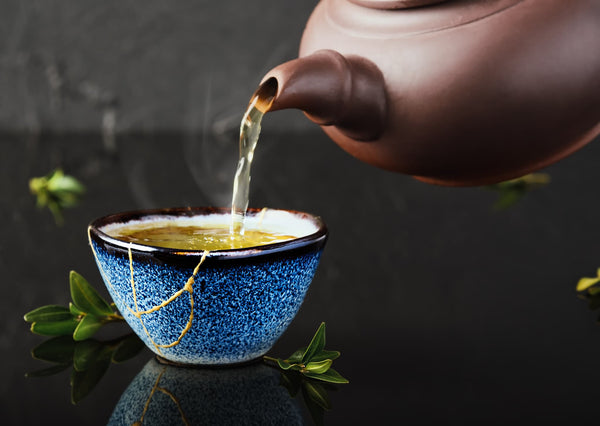
Is Kintsugi Food Safe? Unveiling the Safety of this Artistic Golden Repair Technique
What is Kintsugi?

Kintsugi is a traditional Japanese technique for restoring broken cups, plates, vases, and other vessels, and has been practiced since the Muromachi period (1336-1573), more than 400 years ago, and the technique spread with the development of the tea ceremony. The technique is still used today, and is useful when an important vessel has been broken or when you need to calm your mental state.
Traditional kintsugi, which uses real lacquer, has been the mainstream, but in recent years a "modern kintsugi" method has emerged to make kintsugi easier and more enjoyable. Whether kintsugi is food safe or not depends on this kintsugi method.
Whether Kintsugi is Food Safe Depends on the Raw Materials Used.
The safety of kintsugi for use in mouth-watering tableware depends on the two types of kintsugi techniques. This is because the materials used to repair and glue the vessels are different.
Traditional Kintsugi, Natural Lacquer: Food Safe
Traditional kintsugi uses natural lacquer, which is safe for use on tableware, cups, and other items that are usually used for eating. The method has been practiced in Japan for over 400 years, since the time when there were no synthetic resins, so it is safe to say that it is very safe. Therefore, in the case of traditional kintsugi, it is safe to eat and drink from restored tableware.
Modern Kintsugi and Synthetic Lacquer: Not Food Safe


In recent years, inexpensive kintsugi kits called "modern kintsugi" have been sold and workshops have been held to make it easier to start kintsugi. Since kintsugi dries in a short time, it may be a good way to enjoy kintsugi for the first time. On the other hand, modern kintsugi uses synthetic lacquer and epoxy resin, so it should not be used for tableware. It is not food safe because it is harmful if ingested into the body. Some kintsugi kits using epoxy resin claim to be food safe, but we honestly do not recommend them.
Merits and Demerits of Traditional Kintsugi and Modern Kintsugi
Understanding the characteristics of traditional kintsugi and modern kintsugi will help you enjoy kintsugi more deeply. Let us introduce each of them.
Traditional Kintsugi
Advantages:
- Aesthetic value: Traditional methods have a unique beauty. The patterns and lines made with gold powder highlight the history and broken traces of the vessel.
- Sustainability: The historic technique makes the restored vessels last longer and more durable.
- Cultural Significance: Traditional techniques reflect Japanese culture and philosophy, which is also reflected in the vessels.
Disadvantages
- Time-consuming: Restoration work is time-consuming, so it is not suitable for immediate repairs.
- Risk of lacquer allergy: Care should be taken because of the possibility of allergic reactions to lacquer.
Kintsugi, which is done in the traditional way with real lacquer and gold, is attractive not only because of its safety, but also because of the cultural value of the historical technique used to perform it. Let us integrate the techniques developed over a long history into our modern lives!
Modern Kintsugi
Advantages
- Low difficulty: No special skills required, easy to work with even for beginners.
- Quick repair: The work is quick and the vessels can be restored in a short period of time.
- Low risk of lacquer allergy: Because synthetic lacquer is used, the risk of lacquer allergy is lower than with traditional methods. (Almost no risk of allergy).
Disadvantages
- Harmful to the human body: Synthetic lacquer and adhesives used may contain ingredients harmful to the human body. Care should be taken not to use them on tableware that will be put into the mouth.
- Lack of aesthetic value: The historical value and aesthetic appeal of modern kintsugi may be less than that of traditional methods.
In the case of modern kintsugi, it is basically not recommended to use it for vessels that come in contact with food because of the use of adhesives that are harmful to the body. For example, if the purpose is to restore a vase or vessel for decoration, it should not be a problem.
If Food Safety is the First Priority, Traditional Kintsugi is the Best Choice.
If you are considering food safety, we do not recommend using modern kintsugi that uses glue. For example, if you want to repair a cup for enjoying tea or sake by kintsugi, it is better to use natural lacquer by traditional method. Kintsugi kits using food safe materials can be found here.
In this article, we have discussed two types of food-safe kintsugi: traditional and modern. However, these two methods are not relative and can coexist. Each has its own merits and demerits, and each can be enjoyed in its own way. It is recommended that those who want to enjoy more cultural aspects and historical techniques use the traditional method, while those who want to experience it easily and simply use the modern method. Since there is no right answer for either method, we encourage you to experiment with the method that best suits your values and lifestyle. Kintsugi embodies the philosophy of "accepting things as they are" and "looking toward the future. Let's enjoy your own unique Kintsugi lifestyle.
